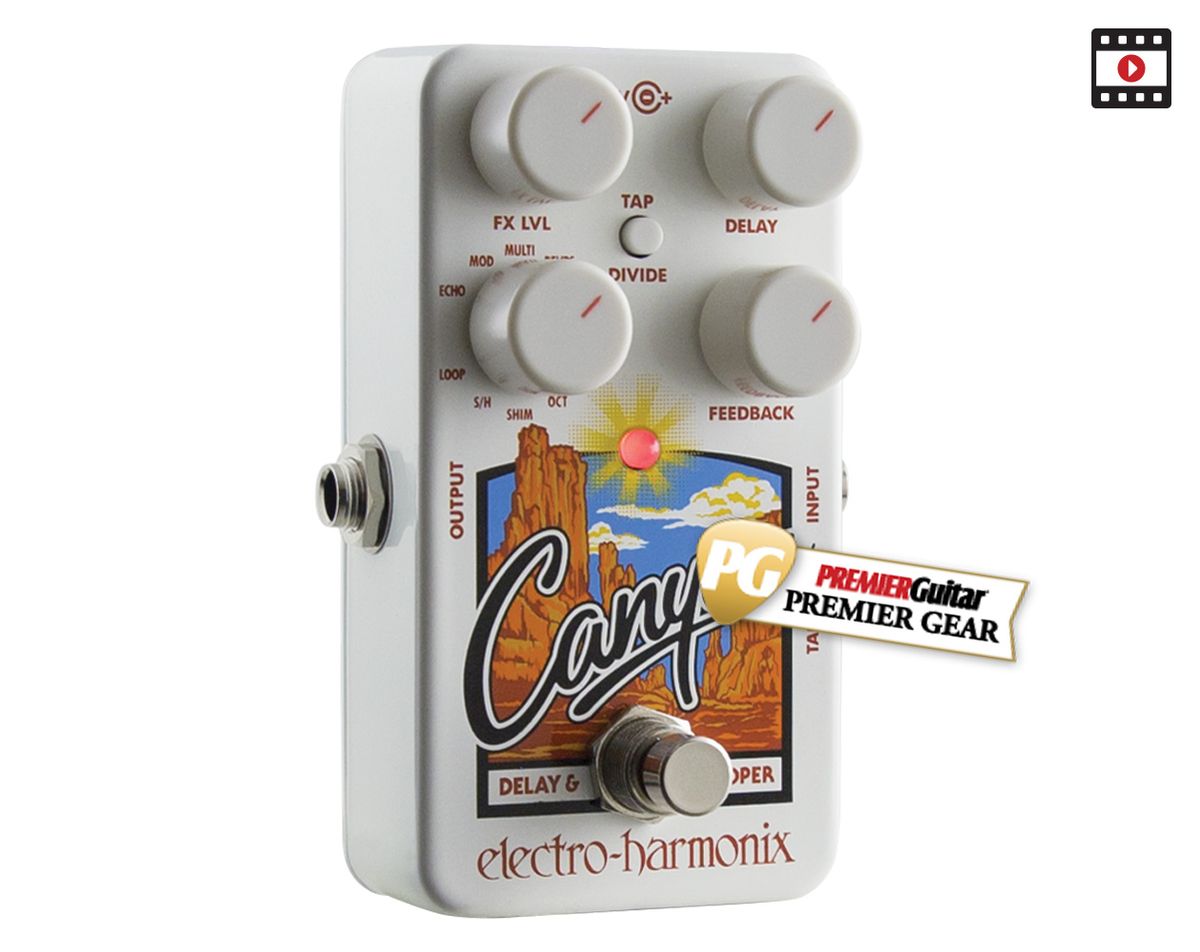Echoes abound in a feature-stuffed and compact delay factory.
Whenever Electro-Harmonix releases a delay pedal, guitarists tend to perk up their ears. Little wonder— the company has a great track record where echo is concerned. The original Deluxe Memory Man secured the EHX’s place in the delay pedal hall of fame decades ago. And modern evolutions of the Memory Man are known for cramming in whole worlds of control that can occupy the most restless tone shaper. The Canyon Delay & Looper takes EHX’s modern digital-delay formula a step further through downsizing. But while Canyon is small, it’s rich with powerful sound-shaping features and echoes that range from familiar to extraterrestrial.
More than Meets the Eye
At a casual first glance, the control layout on the sturdy, Nano-sized metal box struck me as minimal, if well thought-out. The three delay controls—FX level, delay, and feedback—are typical enough. But it’s the mode selector that tips the Canyon’s capable hand. With this one knob you can select any of nine delays, a sample-and-hold function, or a looper.
Ratings
Pros:
Great selection of sounds in an inexpensive, compact pedal. Simple-to-use tap tempo feature. Controls offer immense tone shaping without menu diving.
Cons:
Tap divide button’s LED rhythmic subdivision indicator can be a bit confusing. No stereo operation.
Tones:
Ease of Use:
Build/Design:
Value:
Street:
$139
Electro-Harmonix Canyon Delay & Looper
ehx.com
It’s an efficient design and, impressively, it only scratches the surface of what the pedal can do, because some of the best sounds come from secondary functions that you don’t see among the 11 rotary knob settings. But while the breadth of the functions is impressive, it’s the Canyon's ability to blend these features so seamlessly and simply that really blew me away.
Subtle to Sumptuous Ambiance
Some of the most straightforward modes like mod, and tape settings sound great as is. But by using the tap divide button to access the secondary controls, each expanded into a much more versatile version of itself. The DMM (Deluxe Memory Man) simulation was my favorite, largely because the secondary controls enabled me to dial in the warm modulation and darker repeats that made the original pedal iconic.
Sounds from the shimmer setting were often jaw-droppingly enormous—an effect especially achieved by combining digital simulations of two Memory Mans, a POG 2, and a Soul Preacher compressor into a single setting. Volume swells took on multi-dimensional qualities that made me forget that the pedal only offers mono operation. The reverse and octave delays deliver similarly spacy textures, while the sample-and-hold function will appeal to song and solo architects. I was also thoroughly impressed with the Canyon's looping ability. It inspired long solo jam sessions and became a go-to writing tool.
Simple, Precise Rhythmic Control
Typically, I’m not a big fan of tap tempo on a single-button delay pedal. On one hand, I love the convenience of being able to dial in repeat times on the fly. But that usually comes with having to hold the pedal down for an eternity, tap out the rhythm, then get out of tap mode again—all while maintaining my playing and composure onstage. There are none of these struggles using the Canyon. The brilliant footswitch allows you to get right to tapping. Whether the pedal is on or off, you simply select the subdivisions you want with the tap divide button and tap out your tempo. There’s also an external tap jack for players who prefer slaving delays to another control.
The Verdict
The EHX Canyon Delay & Looper pedal offers classic delay textures, subtle-to-deep ambiance, and modulated washes that are fantastically ethereal. Yet even with powerful secondary functions, I found the pedal very simple to navigate. And it does all this in a standard EHX Nano-sized enclosure. Call this another win in the delay column for Electro-Harmonix.
Watch the Review:
- Electro-Harmonix Nano Deluxe Memory Man Review - Premier Guitar ›
- Electro-Harmonix J Mascis Ram’s Head Big Muff Pi Pedal - Premier Guitar ›
- Electro-Harmonix Launches Andy Summers Walking on the Moon - Premier Guitar ›
- Electro-Harmonix Introduces the New Pico POG Octave Pedal - Premier Guitar ›
- EHX/JHS Lizard Queen Review - Premier Guitar ›
- Is There Really Stompbox Mojo? - Premier Guitar ›
- EHX Unveils NYC DSP Guitar Pedals - Premier Guitar ›



